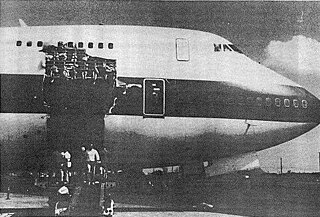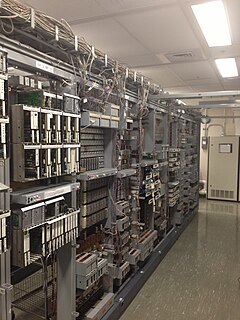| Look up latch or latches in Wiktionary, the free dictionary. |
A latch is a type of door or window fastener.
Contents
Latch may also refer to:
| Look up latch or latches in Wiktionary, the free dictionary. |
A latch is a type of door or window fastener.
Latch may also refer to:

In electronics, a flip-flop or latch is a circuit that has two stable states and can be used to store state information. A flip-flop is a bistable multivibrator. The circuit can be made to change state by signals applied to one or more control inputs and will have one or two outputs. It is the basic storage element in sequential logic. Flip-flops and latches are fundamental building blocks of digital electronics systems used in computers, communications, and many other types of systems.

Latch refers to how the baby fastens onto the breast while breastfeeding. How the baby latches is more important than how the baby is held during nursing. A good latch means that the bottom of the areola is in the baby's mouth and the nipple is back inside his or her mouth, where it's soft and flexible. A shallow, or poor, latch happens when the baby does not have enough of the breast in his/her mouth or is too close to the tip. A shallow latch causes the sensitive nipple skin to press against the bones in the top of the baby's mouth. That can cause the development of cracked nipples. The nipples are sore, and bleed.

"Latch" is a song by English electronic music duo Disclosure, featuring vocals from English singer Sam Smith. It was released as a digital download on 8 October 2012, by PMR Records. The lead single from their debut studio album, Settle (2013), the song debuted on the UK Singles Chart at number 26 and has peaked at number 11. In the United States, "Latch" was a sleeper hit, peaking at number seven on the US Billboard Hot 100 in 2014.
A latching switch is a switch that maintains its state after being activated. A push-to-make, push-to-break switch would therefore be a latching switch – each time you actuate it, whichever state the switch is left in will persist until the switch is actuated again.
| This disambiguation page lists articles associated with the title Latch. If an internal link led you here, you may wish to change the link to point directly to the intended article. |

A relay is an electrically operated switch. Many relays use an electromagnet to mechanically operate a switch, but other operating principles are also used, such as solid-state relays. Relays are used where it is necessary to control a circuit by a separate low-power signal, or where several circuits must be controlled by one signal. The first relays were used in long distance telegraph circuits as amplifiers: they repeated the signal coming in from one circuit and re-transmitted it on another circuit. Relays were used extensively in telephone exchanges and early computers to perform logical operations.
In electrical engineering, a switch is an electrical component that can "make" or "break" an electrical circuit, interrupting the current or diverting it from one conductor to another. The mechanism of a switch removes or restores the conducting path in a circuit when it is operated. It may be operated manually, for example, a light switch or a keyboard button, may be operated by a moving object such as a door, or may be operated by some sensing element for pressure, temperature or flow. A switch will have one or more sets of contacts, which may operate simultaneously, sequentially, or alternately. Switches in high-powered circuits must operate rapidly to prevent destructive arcing, and may include special features to assist in rapidly interrupting a heavy current. Multiple forms of actuators are used for operation by hand or to sense position, level, temperature or flow. Special types are used, for example, for control of machinery, to reverse electric motors, or to sense liquid level. Many specialized forms exist. A common use is control of lighting, where multiple switches may be wired into one circuit to allow convenient control of light fixtures.
Ladder logic was originally a written method to document the design and construction of relay racks as used in manufacturing and process control. Each device in the relay rack would be represented by a symbol on the ladder diagram with connections between those devices shown. In addition, other items external to the relay rack such as pumps, heaters, and so forth would also be shown on the ladder diagram.

Turkish Airlines Flight 981 was a scheduled flight from Istanbul Yesilköy Airport to London Heathrow Airport, with an intermediate stop at Orly Airport in Paris. On 3 March 1974, the McDonnell Douglas DC-10 operating the flight crashed into the Ermenonville Forest, outside Paris, killing all 346 people on board. The crash was also known as the Ermenonville air disaster. At the time, Flight 981 was the deadliest plane crash in aviation history until 27 March 1977, when 583 people perished in the collision of two Boeing 747s in Tenerife. It remained the deadliest single-aircraft accident until the crash of Japan Airlines flight 123 on 12 August 1985, and the deadliest aviation accident without survivors until the Charkhi Dadri mid-air collision on 12 November 1996. It remains the deadliest single-aircraft accident without survivors.
Bounce or The Bounce may refer to:

In railway signalling, an interlocking is an arrangement of signal apparatus that prevents conflicting movements through an arrangement of tracks such as junctions or crossings. The signalling appliances and tracks are sometimes collectively referred to as an interlocking plant. An interlocking is designed so that it is impossible to display a signal to proceed unless the route to be used is proven safe.

American Airlines Flight 96 was a regular domestic flight operated by American Airlines from Los Angeles to New York via Detroit and Buffalo. On June 12, 1972, the left rear cargo door of the McDonnell Douglas DC-10-10 operating the flight blew open and broke off en route between Detroit and Buffalo above Windsor, Ontario; the accident is thus sometimes referred to as the Windsor incident.

United Airlines Flight 811 was a regularly scheduled airline flight from Los Angeles to Sydney, with intermediate stops at Honolulu, and Auckland. On February 24, 1989, the Boeing 747–122 serving the flight experienced a cargo door failure in flight shortly after leaving Honolulu. The resulting explosive decompression blew out several rows of seats, resulting in the deaths of nine passengers. The aircraft returned to Honolulu, where it landed safely.
Network address translator traversal is a computer networking technique of establishing and maintaining Internet protocol connections across gateways that implement network address translation (NAT).

An electronic lock is a locking device which operates by means of electric current. Electric locks are sometimes stand-alone with an electronic control assembly mounted directly to the lock. Electric locks may be connected to an access control system, the advantages of which include: key control, where keys can be added and removed without re-keying the lock cylinder; fine access control, where time and place are factors; and transaction logging, where activity is recorded. Electronic locks can also be remotely monitored and controlled, both to lock and to unlock.
In human-computer interfaces, the X keyboard extension or XKB is a part of the X Window System that extends the ability to control the keyboard over what is offered by the X Window System core protocol. The main features of this extension are:

A wire spring relay is a type of relay, that has springs made from drawn wires of nickel silver, rather than cut from flat sheet metal as in the flat-spring relay. This class of relays provided manufacturing and operating advantages over previous designs. Wire spring relays entered mass production in the early 1950s.

A reed relay is a type of relay that uses an electromagnet to control one or more reed switches. The contacts are of magnetic material and the electromagnet acts directly on them without requiring an armature to move them. Sealed in a long, narrow glass tube, the contacts are protected from corrosion. The glass envelope may contain multiple reed switches or multiple reed switches can be inserted into a single bobbin and actuate simultaneously. Reed switches have been manufactured since the 1930s.

The Number One Electronic Switching System (1ESS) was the first large-scale stored program control (SPC) telephone exchange or electronic switching system in the Bell System. It was manufactured by Western Electric and first placed into service in Succasunna, New Jersey, in May 1965. The switching fabric was composed of a reed relay matrix controlled by wire spring relays which in turn were controlled by a central processing unit (CPU).

A magnetic starter is an electromagnetically operated switch which provides a safe method for starting an electric motor with a large load. Magnetic starters also provide under-voltage and overload protection and an automatic cutoff in the event of a power failure.

Breastfeeding, also known as nursing, is the feeding of babies and young children with milk from a woman's breast. Health professionals recommend that breastfeeding begin within the first hour of a baby's life and continue as often and as much as the baby wants. During the first few weeks of life babies may nurse roughly every two to three hours, and the duration of a feeding is usually ten to fifteen minutes on each breast. Older children feed less often. Mothers may pump milk so that it can be used later when breastfeeding is not possible. Breastfeeding has a number of benefits to both mother and baby, which infant formula lacks.
Cracked nipple is a condition that can occur in breastfeeding women as a result of a number of possible causes. Developing a cracked nipple can result in soreness, dryness or irritation to, or bleeding of, one or both nipples during breastfeeding. The mother with a cracked nipple can have severe nipple pain when the baby is nursing. This severe pain is a disincentive for continued breastfeeding. The crack can appear as a cut across the tip of the nipple and may extend to its the base. Cracked nipples develop after the birth of the infant and is managed with pharmacological and nonpharmacological treatment.
Nipple confusion is the tendency of an infant to unsuccessfully adapt between breast-feeding and bottle-feeding. It can happen when the infant is put back onto breast-feeding. Nipple confusion can turn into nipple refusal in which the infant refuses both the bottle and breastfeeding.